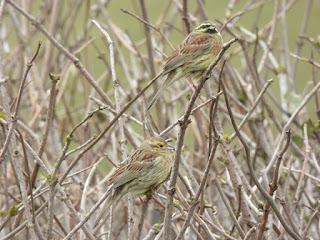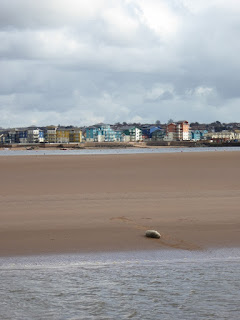My week off work continues and with the glaucous gull reappearing on the River Plym and showing well I headed off to Marsh Mills on March 16th for a look. Arriving at 10am and the tide was an hour off being high. There were a few gulls loafing about on the water and a tiny bit of exposed mud off Blaxton Meadow but scanning through them and there was no sign of the glaucous. The nearby sewage works has been a good place to see the gull too but it was busy with workmen and the rotating arms over the tanks were not operating and so there were no gulls to be seen.
I headed off to the woods and fields for a walk while waiting for the low high tide to turn and drop and found 2 green woodpeckers, my first of the year. A flock of around 20 redwings feeding in a grassy field were a surprise along with 4 mistle thrush. The usual woodland birds were seen along with a jay and a nuthatch.
An Early English Bluebell
Heading back to the River and the tide was finally ebbing. Blaxton Meadow had 37 shelduck and 26 curlew roosting while along the railway embankment 2 greenshank, 50+ redshank and 20+ turnstone were distantly seen. A male white wagtail was quietly singing to itself on the saltmarsh at Blaxton Meadow, keeping itself apart from a small group of around 10 pied wagtails nearby, and 2 meadow pipits were also found.
Male White Wagtail
Gulls started to arrive as the mudflats became exposed but there was no sign of the glaucous gull. I did find 4 adult and 2 1st winter common gulls and a few adult lesser black backed gulls amongst the black headed, herring and greater black backs.
Canada Geese - smaller female on the left
Canada Geese
Summer Plumaged Cormorant
First Winter Great Black Backed Gull with Herring Gulls
2 little grebes and a common sandpiper were also seen along the river near the sewage treatment works which was still full of workmen and not operating and so it was time to head off home to catch up on other things and to lick my wounds after another big old dip.
Thursday 17th and it was off to Lower Tamar Lake on the Cornwall/Devon border, not far away from the caravan at Bude but somewhere we have never visited. My target bird was willow tit with regular sightings on the webpages over the winter period of birds feeding on the bird food put out by local birders by the bird hide. I have only seen willow tit once - or have I? I have one record of willow tit in my bird notes, a single bird feeding high in a tree at Brandon on the Suffolk/Norfolk border back in 1989 - I was 99% certain it was a willow and not a marsh and it has remained on my British list at a 99% certainty since. Today was about changing that percentage to 100%.
It was a bright but cold and breezey day and on arrival I headed off straight away to the bird hide and bird feeders while David went off for a walk. On the Lake were a female goosander, a great crested grebe, a summer plumaged cormorant, mallard, moorhen and tufted ducks, and 5 grey heron were resting in the lakeside reeds. A few blue tits and great tits and chaffinch were around the well stocked feeders but after 15 minutes there was no sign of anything else except for a nice male reed bunting and so I decided to go for a walk instead and to return to the hide later.
Male Reed Bunting
Heading off along the footpath towards the Upper Tamar Lake and after a short walk I noticed a bird feeder hanging in the trees close to the path and a quick look gave me a brief view of a marsh/willow tit as it flew away. And so I settled down on a nearby concrete slab to watch and wait and see what would reappear. Coal, blue and great tits came and went, most dashed in, grabbed some food and flew off into cover but a few were a little more showy. Chaffinch, a jay, a nuthatch and a grey squirrel were also seen along with brief views of marsh/willow tits as they swooped in before dashing off and out of sight.
The birds were resolutely quiet until I heard the distinctive sneezey pitchou calls of marsh tits. Soon after I heard the distinctive call of willow tit, 2 short notes followed by 4 lower and longer notes and with a buzzing quality - zi-zi-tah-tah-tah-tah - quite unlike a call I have heard before - and then I watched as the bird making the call was seen flitting through the branches chasing after a second bird with a third bird also interacting with them nearby - 3 willow tits!
I managed to get some decent but brief views (and some poor photos) of the willow tits along with marsh tits on the feeders and was able to pick out the diagnostic features for willow tit - pale wing panel, extensive white cheeks, dull black cap, buff brown flanks and lack of white at the bill base - but it was difficult with the birds very active and mobile and the light very bright and harsh. But I had properly seen (and heard) willow tit at last and so we headed off to Bude for lunch and a walk around before driving back to Plymouth.
Willow Tit
Starling, Bude





















































